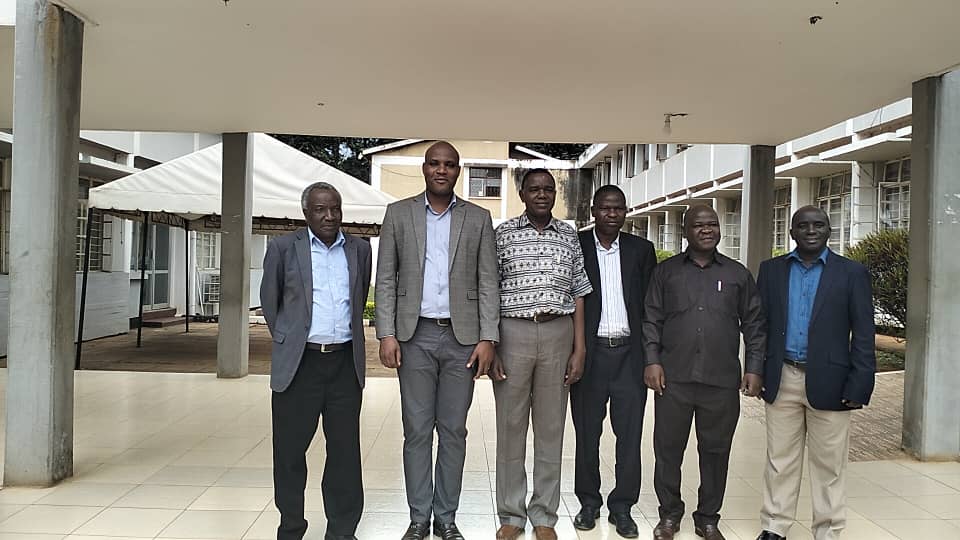 The Department would like to congratulate Fredrick Alleni Mfinanga for defending his PhD thesis entitled, “WATER ACCESS FOR LIVESTOCK AND ITS CONTRIBUTION TO THE LIVELIHOOD STRATEGIES OF PASTORALISTS IN MONDULI DISTRICT, ARUSHA REGION TANZANIA.” The abstract of the thesis is as follows:
The Department would like to congratulate Fredrick Alleni Mfinanga for defending his PhD thesis entitled, “WATER ACCESS FOR LIVESTOCK AND ITS CONTRIBUTION TO THE LIVELIHOOD STRATEGIES OF PASTORALISTS IN MONDULI DISTRICT, ARUSHA REGION TANZANIA.” The abstract of the thesis is as follows:
The study determined the contribution of water access for livestock on the livelihood strategies of pastoralists in Monduli District, Tanzania. Specifically, the study examined water used strategies for livestock by pastoralists; the determinants of water use strategy of charco dam rainwater harvesting technology for livestock; the level of water access for livestock among pastoralists; factors influencing the level of water access for livestock; and the influence of water access for livestock on livelihood strategies (LS) of pastoralists. The study was carried out in Makuyuni and Moita Wards in Monduli District, Tanzania. The study used a cross-sectional research design. Mixed research methods were used for data collection whereby both quantitative and qualitative data were collected. Semi-structured questionnaire was used to collect quantitative data. Key informant’s interviews and Focus Group Discussions (FGDs) were used to collect qualitative data. Descriptive statistics used frequencies and percentages, chi-square, correlation analysis and binary and ordinal and multinomial logistic regression models were used to analyse quantitative data. Qualitative data were analysed using content analysis. The study findings indicate that selling livestock to get money for paying water charges for livestock, water supply for livestock schedules, charco dam rainwater harvesting technology, migration, small ruminant birth control and the use of locally dug wells were the main water strategies for livestock used by pastoralists in study areas. Equally important, pastoralists who were unable to sell livestock to pay for water charges for livestock used several water use strategies such as selling crops, accessing credit through Village Community Bank (VICOBA), working in security jobs, negating in petty trade, retail shop, motorcycle transport business, remittance and selling traditional herbs. Furthermore, the study results show that the intervening factors (perceived advantages and disadvantages of charco dam) have a slightly high influence on the adoption of charco dam with R2 ranging from 29.5 to 44.5 per cent as compared to independent variables at a 5 per cent level of significance. However, the study results indicate that the independent variables namely socio-economic factors specifically age (p=0.000), household size (p=0.002), off-farm income (p=0.025), livestock keeping experience (0.001), herd size (0.002) and institutional factors including access to extension services (p=0.030) and subsidies (p=0.005) have an influence on the adoption of charco dam with predictive power R2 ranging from 27 to 37 per cent at a 5 per cent level of significance. Moreover, the study has established the levels of water access for livestock by using Water Access for Livestock Index (WALIS) with five dimensions namely time taken in watering livestock, distance walked by livestock to water points, the type of water source used, affordability and multiple uses of water source for livestock. The study findings indicate that 76.3 per cent of pastoralist households have a low level of water access for livestock, 2.5 per cent (very few) have a high level of water access for livestock and 21.3 per cent have an average level of water access for livestock. Lack of reliable water sources, long walking distance to water points, spending more time in searching for water and water unaffordability were the causes of low level of water access for livestock. Equally important, the study revealed that off-farm income (p=0.050), access to credit (0.003), access to subsidies (0.000) and the use of donkey cart or tied jerry can onto donkey (0.030) were significant factors influencing the level of water access for livestock. In addition, the findings indicate that a low level of water access for livestock significantly influences the diversification of Livelihood strategies (LS) such as combined LS of livestock keeping and farming (p=0.018) and combined LS of livestock keeping and off-farm income generating activities (p=0.001). On the other hand, the medium level of water access for livestock significantly influences the diversification of LS into only combined LS of livestock keeping and farming activities (p=0.002) while keeping a high level of water access for livestock in the reference category. The study concludes that a low level of water access for livestock has contributed to the diversification of livelihood strategies specifically combined LS of livestock keeping and farming and combined LS of livestock keeping and off-farming activities with the prospect of increasing income portfolio to support water charges for livestock. Therefore, there is a need of improving water access for livestock because it is important in enhancing livestock production and pastoral livelihood in Monduli District.
The Government of Tanzania through the Local Government Authority and other development partners should support or develop long-term solutions, including building improved water sources structures for livestock such as charco dam rainwater harvesting technologies to ensure optimal and long-standing water supply for livestock for increasing their productivity. Moreover, this will guarantee the growth of the livestock production system and give pastoralists a wider selection of livelihood strategies.
